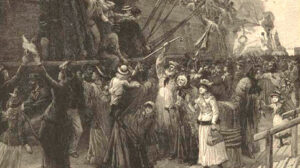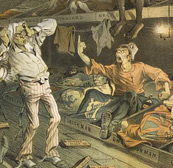
Credit: The New York Public Library, Mid-Manhattan Library Picture collection; published 1898
The Industrial Revolution began in England in the late 18th century and gradually spread across Europe. Fueled by proceeds from natural resources and the African slave trade in the Caribbean, South America and the former colonies, Europe became a center of manufacturing, producing everything from finished cotton goods, to machinery, to luxury items. By the middle of the nineteenth century, the Industrial Revolution had taken hold in the German states, France, and Belgium. Thousands of laborers were displaced by the rapid transformation from agriculture to manufacturing economies. The economic and social changes brought about by these changes caused masses of people to emigrate to the U.S.
- Though the Industrial Revolution was the primary impetus, other factors also prompted emigration from Europe political upheavals, religious persecution, and those seeking adventure. By the 1830s, 150,000 immigrants, mostly from Northern Ireland and England, had found their way to the United States. However, most of the Irish came to America in the 1840s after the potato famine. The greatest influx of European immigrants to the United States occurred between the 1840s and the 1920s. During this era, approximately 37 million immigrants arrived in the United States. Census figures indicate that about 6 million Germans, 4.5 million Irish, 4.75 million Italians, 4.2 million people from England, Scotland and Wales, approximately the same number from the Austro-Hungarian Empire, 2.3 million Scandinavians and 3.3 million people from Russia and the Baltic states entered the United States. Germans and Irish were the majority between the 1840s and the 1870s. In fact, between 1854 and 1892 more Germans arrived in any given year than any other ethnic group, except for three years when they were outnumbered by the Irish. Scandinavia was next to be affected by industrialization, and thousands of Danes, Norwegians, and Swedes emigrated to the United States beginning in the late 1870s. They were followed during the 1880s and 1890s by the mass migration of Italians, Slavs and Jews, driven by industrialization in Southern and Eastern Europe.
- Between 1845 and 1849, the “potato famine” struck Ireland resulting in the Irish diaspora, in which some two million refugees left Ireland for Great Britain, Canada and the U.S. The famine was at least fifty years in the making, due in part to British economic policy, destructive farming methods and the potato “blight,” the fungus that almost instantly destroyed the primary food source for the Irish. The after-effects of the famine continued until 1851. The number of deaths was unrecorded, although various estimates suggest between 500,000 and more than one million died in the five years from 1846. In addition, in excess of one million Irish emigrated to the U.S., Britain, Canada, Australia and elsewhere, while more than one million emigrated over following decades. The treatment of the Irish by the English reflected the continuation of Irish-English hostilities that date back to the 12th century. Scholars have debated whether this was racism or an extreme form of ethnocentrism.
- The Know-Nothing party was a nativist political movement of the 1850s that grew out of fear that major U.S. cities were being overwhelmed by Irish Catholic immigrants. The sentiment against Irish Americans led to hostility against the Democratic Party, which was closely allied with Irish politicians in most major cities. The origin of the term “Know-Nothing” grew out of the secrecy surrounding the party. When a member was asked about its activities, he was supposed to say, “I know nothing.” Though short-lived, the party was active from 1854 to 1856 when it won elections in major cities from Chicago to Boston, and carried the Massachusetts legislature and governorship. When Robert Conrad, the Whig candidate in Philadelphia, was revealed in 1854 as a Know-Nothing, he won by a landslide, promising to crack down on crime, close bars on Sundays and appoint only native-born Americans to office. Their success in the 1854 elections led the KnowNothings to form officially as the American party, absorbing many members of the nearly-defunct Whig party, as well as many Democrats and prohibitionists. The American Party proved so popular that in 1854 its membership increased in a matter of months from 50,000 to over one million. Among other things, their platform called for severe limits on immigration from Catholic countries; restricting political office to native-born Americans; mandating a waiting period of 21 a years before an immigrant could gain citizenship; restricting public school teachers to Protestants; required daily readings of the King James Bible in public schools; and restricting the sale of liquor. But the issue of slavery caused a major decline in the party’s popularity in the North by 1856.
- In 1854, alleged members of the American Party destroyed the block of granite contributed by the Pope for the Washington Monument. They also took over the monument’s building society and controlled it for four years.
- When Know-Nothing Levi Boone was elected mayor of Chicago in 1855, he barred all immigrants from city jobs.
- In 1867, Horatio Alger, a minister, published his first novel in his Ragged Dick series. It was an overwhelming success, and was followed by similar novels and sequels, including Luck and Pluck (1869) and Tattered Tom (1871), all with the same theme: the rise from rags to riches. Alger, whose formula for success was based on luck, pluck and virtue was meant to appeal to European immigrant ideas about the economic promise of the U.S., eventually became synonymous with this theme. The novels were in most respects the same: the struggles of a young boy who escapes poverty through hard work. However, a careful reading reveals that generally it wasn’t the hard work itself that saved the boy, but rather some extraordinary act of bravery or honesty, which caught the notice of a wealthy gentleman, who would then take the boy in as a ward. This may well have been a window into a seamier side of Alger’s own personal life.
Related Posts

Credit: Library of Congress Prints and Photographs Division, published by Mayer Merkel & Ottman, NY, 1882
“Uncle Sam’s Lodging House” shows the Irish as the only new immigrant disrupting order.
“Uncle Sam’s Lodging House” cartoon from an 1882 edition of Puck magazine shows a boarding house filled with immigrant laborers; the Irishman is the only disruptive immigrant. Puck was a humor and political satire magazine that favored German Americans and pilloried Irish Americans. Some of its targets included New York City’s Irish-controlled Tammany Hall and the Catholic church.




